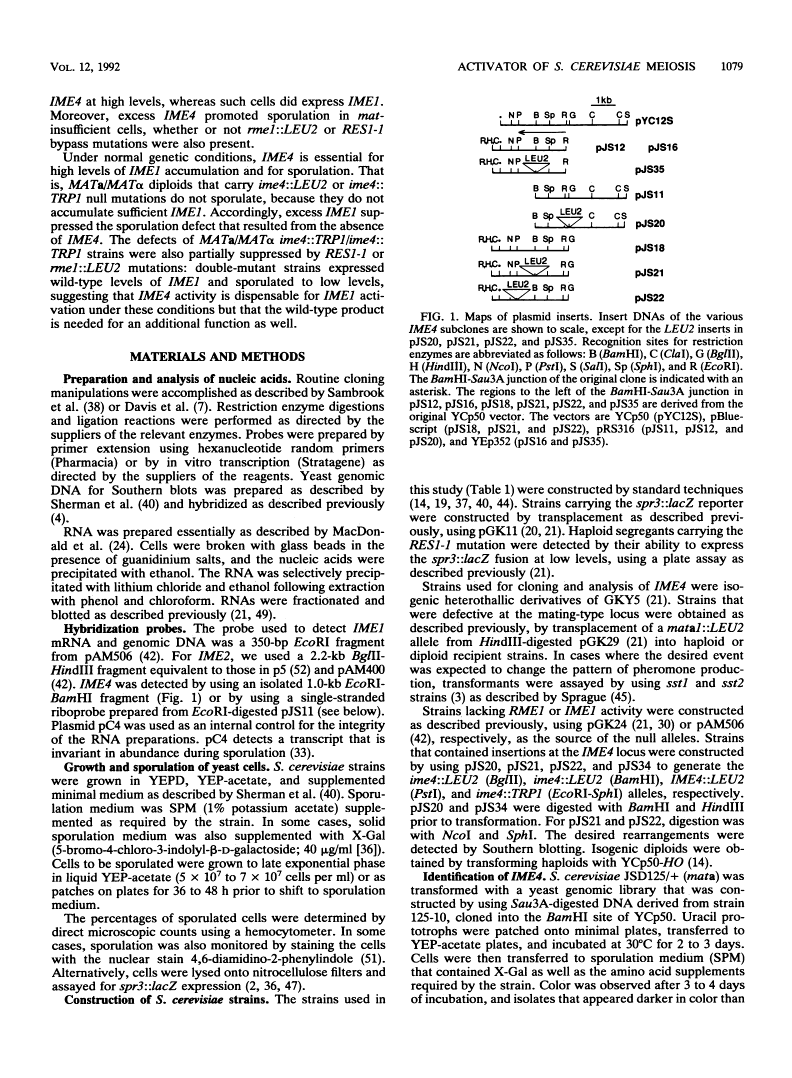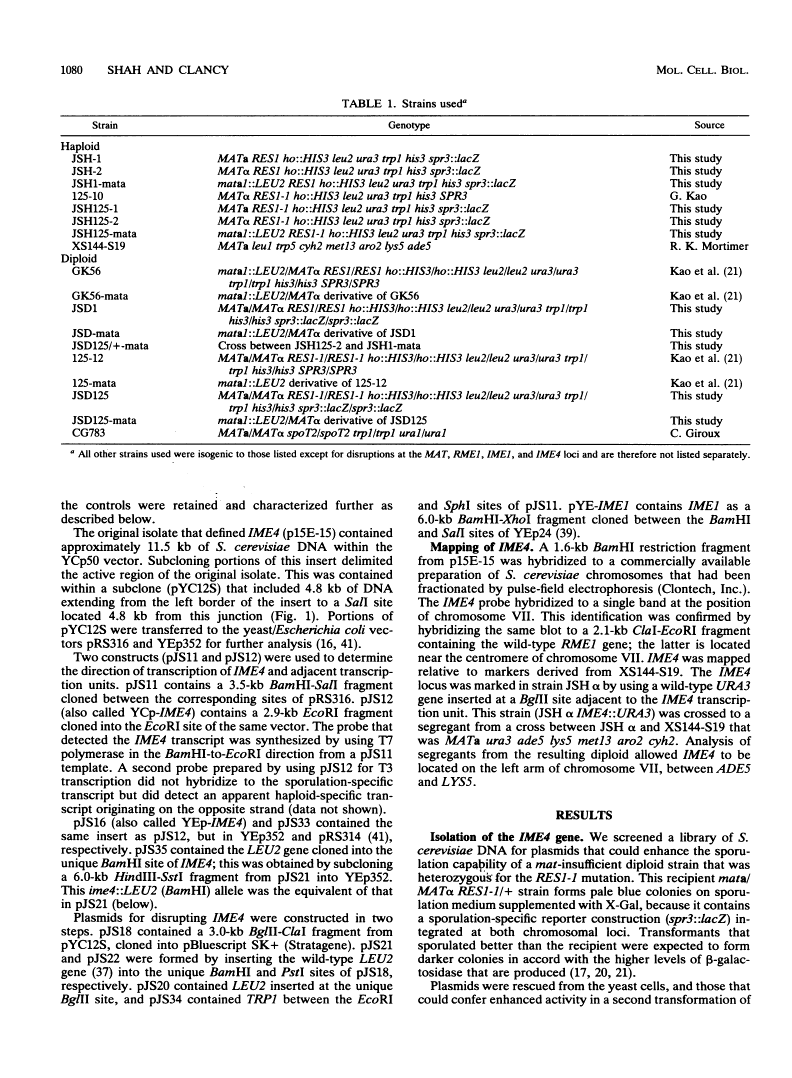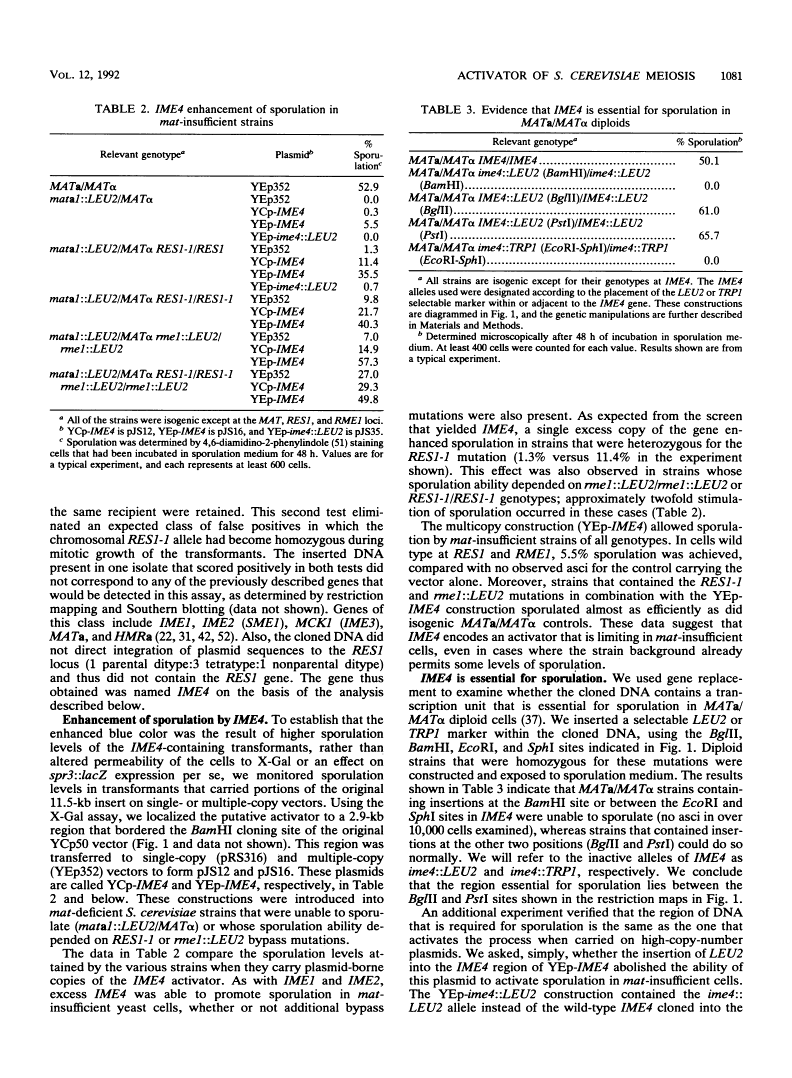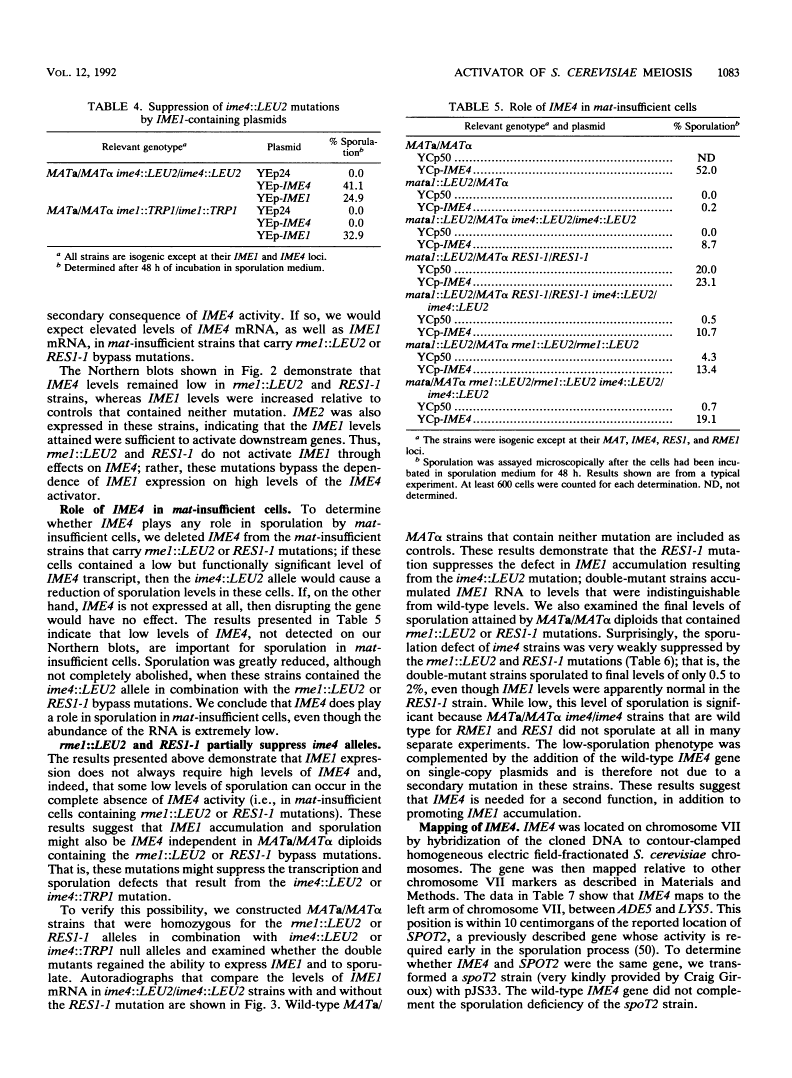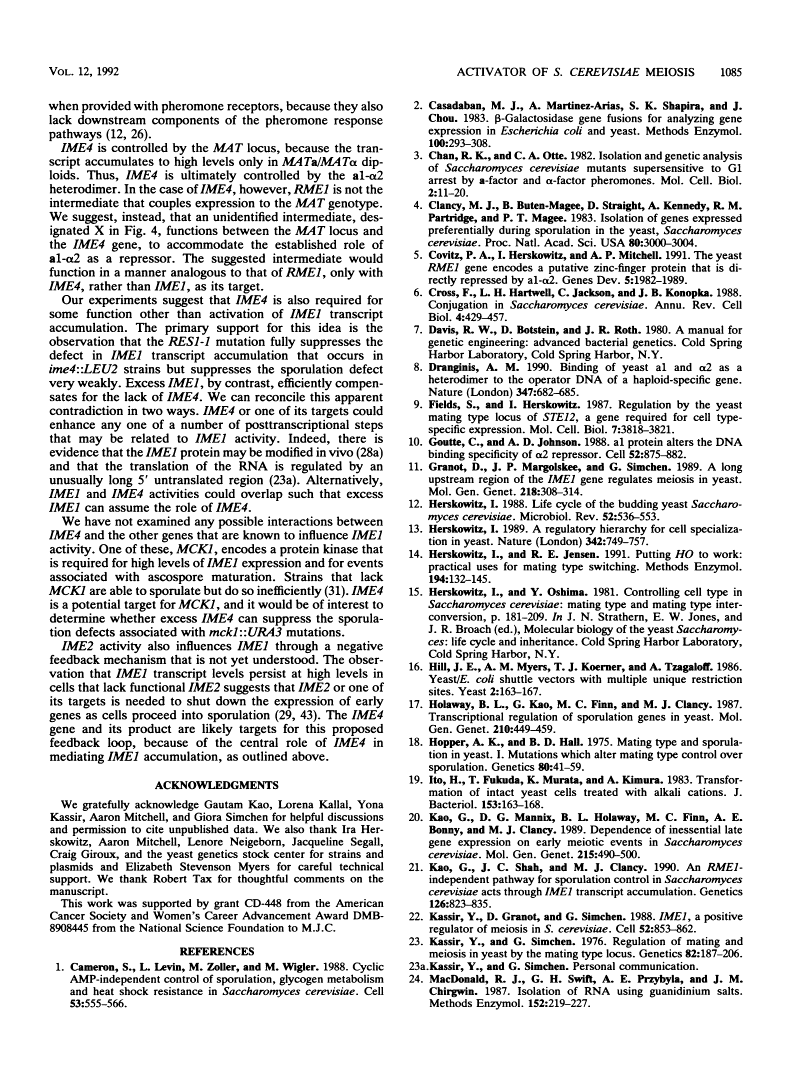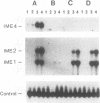Abstract
Free full text

IME4, a gene that mediates MAT and nutritional control of meiosis in Saccharomyces cerevisiae.
Abstract
In the yeast Saccharomyces cerevisiae, sporulation occurs in response to nutritional and genetic signals. The process is initiated when nutrient availability limits mitotic growth, but only in MATa/MAT alpha diploid cells. Under these conditions, the cells express an activator of meiosis (IME1), which is required for the expression of early sporulation-specific genes. We describe a new gene, IME4, whose activity is essential for IME1 transcript accumulation and sporulation. The IME4 transcript was induced in starved MATa/MAT alpha diploids but not in other cell types. In addition, excess IME4 promoted sporulation in mat-insufficient cells. Thus, IME4 appears to activate IME1 in response to cell type and nutritional signals. We have also explored the interactions between IME4 and two genes that are known to regulate IME1 expression. Normally, cells that lack complete MAT information cannot sporulate; when such strains lack RME1 activity or contain the semidominant RES1-1 mutation, however, they can express IME1 and sporulate to low levels. Our results show that mat-insufficient strains containing rme1::LEU2 or RES1-1 bypass mutations still retain MAT control of IME4 expression. Even though IME4 levels remained low, the rme1::LEU2 and RES1-1 mutations allowed IME1 accumulation, implying that these mutations do not require IME4 to exert their effects. In accord with this interpretation, the RES1-1 mutation allowed IME1 accumulation in MATa/MAT alpha strains that contain ime4::LEU2 alleles. These strains still sporulated poorly, suggesting that IME4 plays a role in sporulation in addition to promoting IME1 transcript accumulation. IME4 is located between ADE5 and LYS5 on chromosome VII.
Full text
Full text is available as a scanned copy of the original print version. Get a printable copy (PDF file) of the complete article (1.8M), or click on a page image below to browse page by page. Links to PubMed are also available for Selected References.
Images in this article
Selected References
These references are in PubMed. This may not be the complete list of references from this article.
- Cameron S, Levin L, Zoller M, Wigler M. cAMP-independent control of sporulation, glycogen metabolism, and heat shock resistance in S. cerevisiae. Cell. 1988 May 20;53(4):555–566. [Abstract] [Google Scholar]
- Casadaban MJ, Martinez-Arias A, Shapira SK, Chou J. Beta-galactosidase gene fusions for analyzing gene expression in escherichia coli and yeast. Methods Enzymol. 1983;100:293–308. [Abstract] [Google Scholar]
- Chan RK, Otte CA. Isolation and genetic analysis of Saccharomyces cerevisiae mutants supersensitive to G1 arrest by a factor and alpha factor pheromones. Mol Cell Biol. 1982 Jan;2(1):11–20. [Europe PMC free article] [Abstract] [Google Scholar]
- Clancy MJ, Buten-Magee B, Straight DJ, Kennedy AL, Partridge RM, Magee PT. Isolation of genes expressed preferentially during sporulation in the yeast Saccharomyces cerevisiae. Proc Natl Acad Sci U S A. 1983 May;80(10):3000–3004. [Europe PMC free article] [Abstract] [Google Scholar]
- Covitz PA, Herskowitz I, Mitchell AP. The yeast RME1 gene encodes a putative zinc finger protein that is directly repressed by a1-alpha 2. Genes Dev. 1991 Nov;5(11):1982–1989. [Abstract] [Google Scholar]
- Cross F, Hartwell LH, Jackson C, Konopka JB. Conjugation in Saccharomyces cerevisiae. Annu Rev Cell Biol. 1988;4:429–457. [Abstract] [Google Scholar]
- Dranginis AM. Binding of yeast a1 and alpha 2 as a heterodimer to the operator DNA of a haploid-specific gene. Nature. 1990 Oct 18;347(6294):682–685. [Abstract] [Google Scholar]
- Fields S, Herskowitz I. Regulation by the yeast mating-type locus of STE12, a gene required for cell-type-specific expression. Mol Cell Biol. 1987 Oct;7(10):3818–3821. [Europe PMC free article] [Abstract] [Google Scholar]
- Goutte C, Johnson AD. a1 protein alters the DNA binding specificity of alpha 2 repressor. Cell. 1988 Mar 25;52(6):875–882. [Abstract] [Google Scholar]
- Granot D, Margolskee JP, Simchen G. A long region upstream of the IME1 gene regulates meiosis in yeast. Mol Gen Genet. 1989 Aug;218(2):308–314. [Abstract] [Google Scholar]
- Herskowitz I. Life cycle of the budding yeast Saccharomyces cerevisiae. Microbiol Rev. 1988 Dec;52(4):536–553. [Europe PMC free article] [Abstract] [Google Scholar]
- Herskowitz I. A regulatory hierarchy for cell specialization in yeast. Nature. 1989 Dec 14;342(6251):749–757. [Abstract] [Google Scholar]
- Herskowitz I, Jensen RE. Putting the HO gene to work: practical uses for mating-type switching. Methods Enzymol. 1991;194:132–146. [Abstract] [Google Scholar]
- Hill JE, Myers AM, Koerner TJ, Tzagoloff A. Yeast/E. coli shuttle vectors with multiple unique restriction sites. Yeast. 1986 Sep;2(3):163–167. [Abstract] [Google Scholar]
- Holaway BL, Kao G, Finn MC, Clancy MJ. Transcriptional regulation of sporulation genes in yeast. Mol Gen Genet. 1987 Dec;210(3):449–459. [Abstract] [Google Scholar]
- Hopper AK, Hall BD. Mating type and sporulation in yeast. I. Mutations which alter mating-type control over sporulation. Genetics. 1975 May;80(1):41–59. [Europe PMC free article] [Abstract] [Google Scholar]
- Ito H, Fukuda Y, Murata K, Kimura A. Transformation of intact yeast cells treated with alkali cations. J Bacteriol. 1983 Jan;153(1):163–168. [Europe PMC free article] [Abstract] [Google Scholar]
- Kao G, Mannix DG, Holaway BL, Finn MC, Bonny AE, Clancy MJ. Dependence of inessential late gene expression on early meiotic events in Saccharomyces cerevisiae. Mol Gen Genet. 1989 Feb;215(3):490–500. [Abstract] [Google Scholar]
- Kao G, Shah JC, Clancy MJ. An RME1-independent pathway for sporulation control in Saccharomyces cerevisiae acts through IME1 transcript accumulation. Genetics. 1990 Dec;126(4):823–835. [Europe PMC free article] [Abstract] [Google Scholar]
- Kassir Y, Granot D, Simchen G. IME1, a positive regulator gene of meiosis in S. cerevisiae. Cell. 1988 Mar 25;52(6):853–862. [Abstract] [Google Scholar]
- Kassir Y, Simchen G. Regulation of mating and meiosis in yeast by the mating-type region. Genetics. 1976 Feb;82(2):187–206. [Europe PMC free article] [Abstract] [Google Scholar]
- MacDonald RJ, Swift GH, Przybyla AE, Chirgwin JM. Isolation of RNA using guanidinium salts. Methods Enzymol. 1987;152:219–227. [Abstract] [Google Scholar]
- Malone RE. Dual regulation of meiosis in yeast. Cell. 1990 May 4;61(3):375–378. [Abstract] [Google Scholar]
- Marsh L, Herskowitz I. From membrane to nucleus: the pathway of signal transduction in yeast and its genetic control. Cold Spring Harb Symp Quant Biol. 1988;53(Pt 2):557–565. [Abstract] [Google Scholar]
- Matsuura A, Treinin M, Mitsuzawa H, Kassir Y, Uno I, Simchen G. The adenylate cyclase/protein kinase cascade regulates entry into meiosis in Saccharomyces cerevisiae through the gene IME1. EMBO J. 1990 Oct;9(10):3225–3232. [Europe PMC free article] [Abstract] [Google Scholar]
- Miller AM, MacKay VL, Nasmyth KA. Identification and comparison of two sequence elements that confer cell-type specific transcription in yeast. Nature. 1985 Apr 18;314(6012):598–603. [Abstract] [Google Scholar]
- Mitchell AP, Driscoll SE, Smith HE. Positive control of sporulation-specific genes by the IME1 and IME2 products in Saccharomyces cerevisiae. Mol Cell Biol. 1990 May;10(5):2104–2110. [Europe PMC free article] [Abstract] [Google Scholar]
- Mitchell AP, Herskowitz I. Activation of meiosis and sporulation by repression of the RME1 product in yeast. Nature. 319(6056):738–742. [Abstract] [Google Scholar]
- Neigeborn L, Mitchell AP. The yeast MCK1 gene encodes a protein kinase homolog that activates early meiotic gene expression. Genes Dev. 1991 Apr;5(4):533–548. [Abstract] [Google Scholar]
- Olempska-Beer Z, Freese E. Initiation of meiosis and sporulation in Saccharomyces cerevisiae does not require a decrease in cyclic AMP. Mol Cell Biol. 1987 Jun;7(6):2141–2147. [Europe PMC free article] [Abstract] [Google Scholar]
- Percival-Smith A, Segall J. Characterization and mutational analysis of a cluster of three genes expressed preferentially during sporulation of Saccharomyces cerevisiae. Mol Cell Biol. 1986 Jul;6(7):2443–2451. [Europe PMC free article] [Abstract] [Google Scholar]
- Perkins DD. Biochemical Mutants in the Smut Fungus Ustilago Maydis. Genetics. 1949 Sep;34(5):607–626. [Europe PMC free article] [Abstract] [Google Scholar]
- Rine J, Sprague GF, Jr, Herskowitz I. rme1 Mutation of Saccharomyces cerevisiae: map position and bypass of mating type locus control of sporulation. Mol Cell Biol. 1981 Oct;1(10):958–960. [Europe PMC free article] [Abstract] [Google Scholar]
- Rose M, Botstein D. Construction and use of gene fusions to lacZ (beta-galactosidase) that are expressed in yeast. Methods Enzymol. 1983;101:167–180. [Abstract] [Google Scholar]
- Rothstein RJ. One-step gene disruption in yeast. Methods Enzymol. 1983;101:202–211. [Abstract] [Google Scholar]
- Schneider JC, Guarente L. Vectors for expression of cloned genes in yeast: regulation, overproduction, and underproduction. Methods Enzymol. 1991;194:373–388. [Abstract] [Google Scholar]
- Sikorski RS, Hieter P. A system of shuttle vectors and yeast host strains designed for efficient manipulation of DNA in Saccharomyces cerevisiae. Genetics. 1989 May;122(1):19–27. [Europe PMC free article] [Abstract] [Google Scholar]
- Smith HE, Mitchell AP. A transcriptional cascade governs entry into meiosis in Saccharomyces cerevisiae. Mol Cell Biol. 1989 May;9(5):2142–2152. [Europe PMC free article] [Abstract] [Google Scholar]
- Smith HE, Su SS, Neigeborn L, Driscoll SE, Mitchell AP. Role of IME1 expression in regulation of meiosis in Saccharomyces cerevisiae. Mol Cell Biol. 1990 Dec;10(12):6103–6113. [Europe PMC free article] [Abstract] [Google Scholar]
- Southern EM. Detection of specific sequences among DNA fragments separated by gel electrophoresis. J Mol Biol. 1975 Nov 5;98(3):503–517. [Abstract] [Google Scholar]
- Sprague GF., Jr Assay of yeast mating reaction. Methods Enzymol. 1991;194:77–93. [Abstract] [Google Scholar]
- Strathern J, Hicks J, Herskowitz I. Control of cell type in yeast by the mating type locus. The alpha 1-alpha 2 hypothesis. J Mol Biol. 1981 Apr 15;147(3):357–372. [Abstract] [Google Scholar]
- Strich R, Slater MR, Esposito RE. Identification of negative regulatory genes that govern the expression of early meiotic genes in yeast. Proc Natl Acad Sci U S A. 1989 Dec;86(24):10018–10022. [Europe PMC free article] [Abstract] [Google Scholar]
- Tatchell K, Robinson LC, Breitenbach M. RAS2 of Saccharomyces cerevisiae is required for gluconeogenic growth and proper response to nutrient limitation. Proc Natl Acad Sci U S A. 1985 Jun;82(11):3785–3789. [Europe PMC free article] [Abstract] [Google Scholar]
- Thomas PS. Hybridization of denatured RNA transferred or dotted nitrocellulose paper. Methods Enzymol. 1983;100:255–266. [Abstract] [Google Scholar]
- Tsuboi M. The isolation and genetic analysis of sporulation-deficient mutants in Saccharomyces cerevisiae. Mol Gen Genet. 1983;191(1):17–21. [Abstract] [Google Scholar]
- Williamson DH, Fennell DJ. The use of fluorescent DNA-binding agent for detecting and separating yeast mitochondrial DNA. Methods Cell Biol. 1975;12:335–351. [Abstract] [Google Scholar]
- Yoshida M, Kawaguchi H, Sakata Y, Kominami K, Hirano M, Shima H, Akada R, Yamashita I. Initiation of meiosis and sporulation in Saccharomyces cerevisiae requires a novel protein kinase homologue. Mol Gen Genet. 1990 Apr;221(2):176–186. [Abstract] [Google Scholar]
Associated Data
Articles from Molecular and Cellular Biology are provided here courtesy of Taylor & Francis
Full text links
Read article at publisher's site: https://doi.org/10.1128/mcb.12.3.1078-1086.1992
Read article for free, from open access legal sources, via Unpaywall:
https://europepmc.org/articles/pmc369539?pdf=render
Free to read at mcb.asm.org
http://mcb.asm.org/cgi/content/abstract/12/3/1078
Free after 4 months at mcb.asm.org
http://mcb.asm.org/cgi/reprint/12/3/1078
Citations & impact
Impact metrics
Citations of article over time
Article citations
The Role of N6-methyladenosine Modification in Gametogenesis and Embryogenesis: Impact on Fertility.
Genomics Proteomics Bioinformatics, 22(4):qzae050, 01 Oct 2024
Cited by: 0 articles | PMID: 38937660 | PMCID: PMC11514847
Review Free full text in Europe PMC
The transcriptional regulator Ume6 is a major driver of early gene expression during gametogenesis.
Genetics, 225(2):iyad123, 01 Oct 2023
Cited by: 3 articles | PMID: 37431893 | PMCID: PMC10550318
Meiosis in budding yeast.
Genetics, 225(2):iyad125, 01 Oct 2023
Cited by: 7 articles | PMID: 37616582 | PMCID: PMC10550323
Review Free full text in Europe PMC
The yeast RNA methylation complex consists of conserved yet reconfigured components with m6A-dependent and independent roles.
Elife, 12:RP87860, 25 Jul 2023
Cited by: 7 articles | PMID: 37490041 | PMCID: PMC10393049
Manipulation of IME4 expression, a global regulation strategy for metabolic engineering in Saccharomyces cerevisiae.
Acta Pharm Sin B, 13(6):2795-2806, 10 Jan 2023
Cited by: 2 articles | PMID: 37425036 | PMCID: PMC10326246
Go to all (99) article citations
Data
Similar Articles
To arrive at the top five similar articles we use a word-weighted algorithm to compare words from the Title and Abstract of each citation.
An RME1-independent pathway for sporulation control in Saccharomyces cerevisiae acts through IME1 transcript accumulation.
Genetics, 126(4):823-835, 01 Dec 1990
Cited by: 8 articles | PMID: 2076816 | PMCID: PMC1204281
Role of IME1 expression in regulation of meiosis in Saccharomyces cerevisiae.
Mol Cell Biol, 10(12):6103-6113, 01 Dec 1990
Cited by: 89 articles | PMID: 2247050 | PMCID: PMC362885
IME1, a positive regulator gene of meiosis in S. cerevisiae.
Cell, 52(6):853-862, 01 Mar 1988
Cited by: 206 articles | PMID: 3280136
Genetic regulation of differentiation towards meiosis in the yeast Saccharomyces cerevisiae.
Genome, 31(1):95-99, 01 Jan 1989
Cited by: 11 articles | PMID: 2687111
Review

